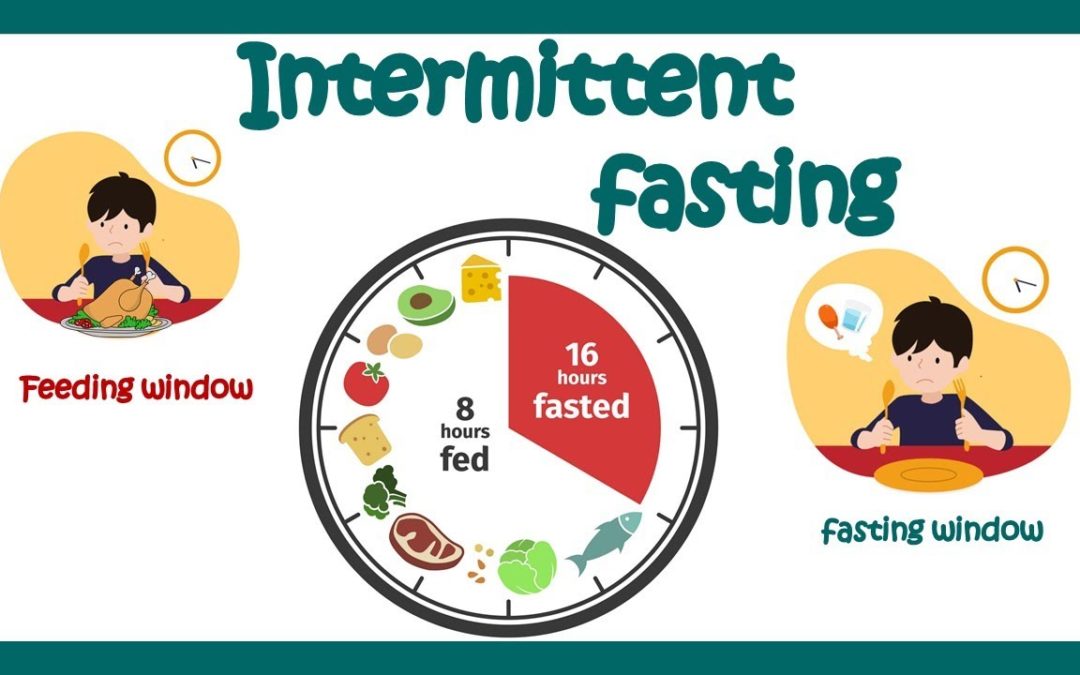Intermittent fasting (IF) is an eating pattern that alternates between periods of eating and fasting. Unlike traditional diets that focus on what to eat, intermittent fasting is more about when to eat. There are several methods of intermittent fasting, but the common principle is cycling between periods of eating and fasting.
Popular Methods of Intermittent Fasting:
- 16/8 Method
- 5:2 Diet
- Eat-Stop-Eat
- Alternate-Day Fasting
16/8 Method

The 16/8 method is a popular form of intermittent fasting that involves dividing the day into two main periods: a fasting window and an eating window. The numbers “16/8” represent the hours spent in each phase, with 16 hours dedicated to fasting and an 8-hour window designated for eating.
Here’s how the 16/8 method typically works:
- Fasting Period (16 hours):
During this time, you abstain from consuming calories. However, you can still drink water, tea, and black coffee, as these beverages usually don’t significantly impact the fasting state. - Eating Window (8 hours):
This is the period when you consume all your daily calories. For example, if you choose to start eating at noon, you would finish your last meal by 8 p.m. The goal is to fit all your meals and snacks within this 8-hour timeframe.
Example of a 16/8 Intermittent Fasting Schedule:
- 8:00 AM: Begin fasting
- 12:00 PM: Start the eating window
- 8:00 PM: Finish the last meal
- 8:00 PM–8:00 AM: Continue fasting
Benefits of the 16/8 Method:
- Simplicity: It’s straightforward and easy to follow, making it a practical option for many people.
- Weight Management: By restricting the eating window, individuals may naturally reduce their calorie intake, leading to weight loss.
- Improved Insulin Sensitivity: The 16/8 method may enhance insulin sensitivity, potentially reducing the risk of type 2 diabetes.
- Convenience: It can be adapted to different lifestyles, and the flexibility of the eating window makes it feasible for various schedules.
- Potential Health Benefits: Some studies suggest that intermittent fasting methods, including the 16/8 approach, may offer health benefits such as improved metabolic health and reduced inflammation.
Before starting any intermittent fasting regimen, it’s advisable to consult with a healthcare professional, especially for individuals with pre-existing health conditions or concerns. Additionally, it’s important to prioritize nutritious food choices during the eating window to ensure that you meet your nutritional needs.
5:2 Diet
The 5:2 diet is a form of intermittent fasting that involves cycling between periods of regular eating and periods of significant calorie reduction. The name “5:2” represents the weekly schedule, with five days of normal eating and two non-consecutive days of “fasting” or restricted calorie intake.
Key Features of the 5:2 Diet:
- Regular Eating Days (5 days):
During these days, individuals can eat a regular, balanced diet without strict calorie restrictions. - Fasting or Reduced Calorie Days (2 days):
On these two days, individuals consume a significantly reduced amount of calories, typically around 500-600 calories for the entire day. These days are often referred to as “fasting” days, but they still involve some calorie intake.
Example of a 5:2 Diet Week:
• Monday (Regular Eating Day)
• Tuesday (Fasting Day – 500-600 calories)
• Wednesday (Regular Eating Day)
• Thursday (Fasting Day – 500-600 calories)
• Friday (Regular Eating Day)
• Saturday (Regular Eating Day)
• Sunday (Regular Eating Day)
Benefits of the 5:2 Diet:
1. Weight Loss: By reducing calorie intake on two non-consecutive days, individuals may create a calorie deficit, leading to weight loss over time.
2. Simplicity: The 5:2 diet is relatively easy to follow, as it doesn’t require daily calorie counting or constant monitoring.
3. Flexibility: The non-fasting days offer flexibility and allow individuals to enjoy a regular diet most of the week.
4. Improved Metabolic Health: Some studies suggest that intermittent fasting, including the 5:2 approach, may improve insulin sensitivity and metabolic health.
5. Potential Longevity Benefits: There is ongoing research exploring the potential effects of intermittent fasting on longevity, although more research is needed in this area.
Before starting the 5:2 diet or any form of intermittent fasting, it’s recommended to consult with a healthcare professional, especially for those with underlying health conditions. Additionally, attention to nutrient-dense foods on both regular and fasting days is crucial for overall health.
Eat-Stop-Eat
Eat-Stop-Eat is a form of intermittent fasting that involves periodic 24-hour fasts. The key feature of this approach is a full day of fasting, where no calories are consumed, followed by a regular eating day. This cycle is typically repeated 1-2 times per week.
Key Features of Eat-Stop-Eat:
- Fasting Period (24 hours):
During this phase, individuals abstain from consuming any calories. This usually involves fasting from dinner one day to dinner the next day, creating a full 24-hour fasting window. - Regular Eating Days (non-fasting days):
On non-fasting days, individuals eat their regular, balanced diet without specific calorie restrictions.
Example of an Eat-Stop-Eat Fasting Cycle:
• Monday (Regular Eating Day)
• Tuesday (Fasting Day – 24 hours of no calorie intake)
• Wednesday (Regular Eating Day)
This cycle can be repeated once or twice per week, depending on individual preferences and goals.
Benefits of Eat-Stop-Eat:
1. Simplicity: The 24-hour fasting period simplifies the approach, as it involves complete fasting for a specific time, making it easy to understand and follow.
2. Caloric Deficit for Weight Loss: By incorporating regular 24-hour fasts, individuals may naturally create a caloric deficit over time, leading to weight loss.
3. Potential Metabolic Benefits: Some studies suggest that intermittent fasting methods, including Eat-Stop-Eat, may have positive effects on metabolic health, including improved insulin sensitivity.
4. Autophagy: Fasting for an extended period may stimulate autophagy, a cellular repair process where cells remove damaged components.
5. Flexibility: Eat-Stop-Eat offers flexibility in terms of choosing which days to incorporate the 24-hour fasts, making it adaptable to different schedules.
Before starting any intermittent fasting regimen, including Eat-Stop-Eat, it’s advisable to consult with a healthcare professional, especially for individuals with pre-existing health conditions. Adequate hydration is crucial during fasting periods, and attention to balanced nutrition on non-fasting days is important for overall health.
Alternate-Day Fasting
Alternate-Day Fasting (ADF) is a form of intermittent fasting that involves alternating between days of regular eating and days of either complete fasting or significant calorie reduction. The key characteristic is the alternating pattern of “feast” days and “fast” days.
Key Features of Alternate-Day Fasting:
- Feast Days (Regular Eating):
On feast days, individuals can eat a regular, balanced diet without strict calorie restrictions. It’s a day of normal eating. - Fast Days (Reduced Calorie or No Calorie Intake):
On fast days, individuals either consume a significantly reduced number of calories (around 500–600 calories) or abstain from eating altogether.
Example of an Alternate-Day Fasting Cycle:
• Monday (Feast Day)
• Tuesday (Fast Day)
• Wednesday (Feast Day)
• Thursday (Fast Day)
This cycle of alternating between feast and fast days continues.
Benefits of Alternate-Day Fasting:
- Weight Loss: ADF may lead to weight loss by creating a caloric deficit over the course of the week.
- Improved Metabolic Health: Some studies suggest that intermittent fasting methods, including ADF, may improve insulin sensitivity and metabolic markers.
- Simplicity: The alternating pattern is relatively simple to follow, and it doesn’t require daily calorie counting.
- Potential Cardiovascular Benefits: Some research indicates that ADF may have positive effects on cardiovascular health, including reducing risk factors for heart disease.
- Autophagy: Fasting days may stimulate autophagy, a cellular repair process that removes damaged components from cells.
- Adaptability: ADF can be adapted to different schedules, allowing individuals to choose which days to designate as feast or fast days.
It’s important to note that while ADF may offer benefits, it may not be suitable for everyone. Individuals with pre-existing health conditions or concerns should consult with a healthcare professional before starting any intermittent fasting regimen. Additionally, staying hydrated is crucial on both feast and fast days, and attention to nutrient-dense foods on eating days is important for overall health.


